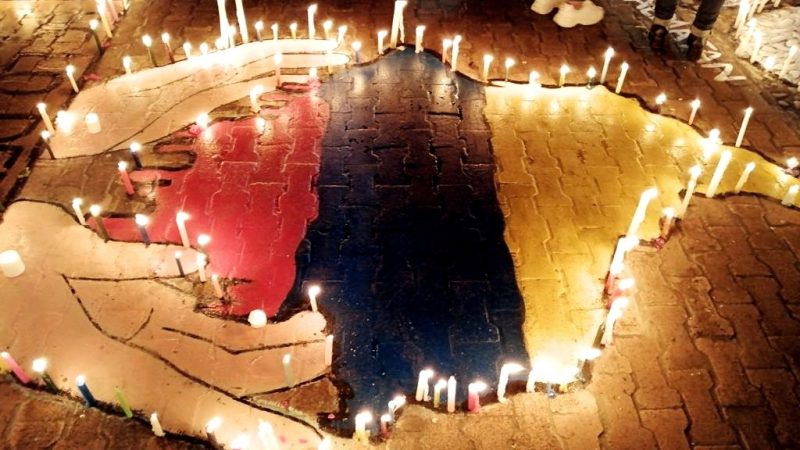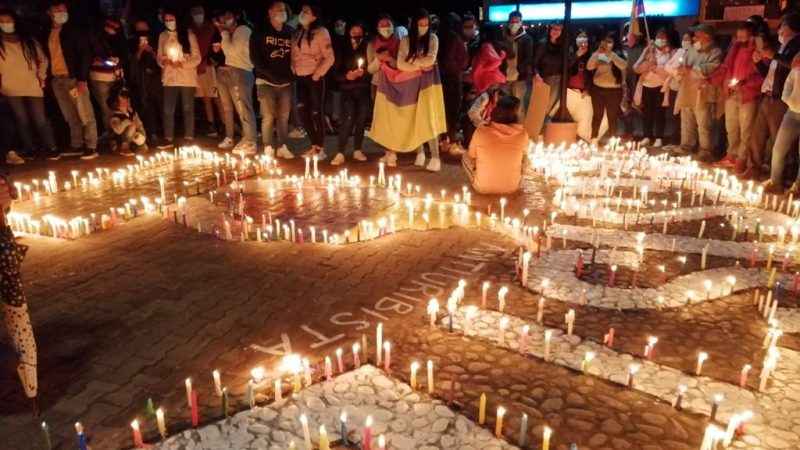
Photo of a vigil during the protests in Colombia in May 2021, by Roger Vallejo, Director of the Sindamanoy de Nariño radio network, used with permission.
As the protests continue in Colombia against the government of President Iván Duque, the battle for information intensifies. The number of victims is increasing but data is scarce and difficult to access.
Most data on the protests is coming from NGOs such as the Indepaz agency and the Temblores organization, as opposed to the Colombian state. For example, despite the fact that thousands of people have been marching peacefully, confrontations and excessive use of force by the security forces have so far left 47 dead, 963 arrested and 548 missing, according to the Indepaz report.
Government offices say that they are monitoring the protests and investigating crimes related to the marches, including homicides and disappearances. But the records of government agencies such as the Office of the Ombudsman, the Prosecutor's Office, and the Attorney General's Office, who are responsible for keeping an official record of deaths, arrests and disappearances, have been inconsistent, according to Diana Salas, a journalist from Colombian news outlet Cuestión Pública. In an episode of En Vivo, Salas explains, “There is no data! And instead of an open data policy, all we have is one of secrecy and suppression.”
The journalist talks about the difficulties she encounters in trying to inform the public about the detained protesters. “Cuestión Pública had to resort to legal action to obtain access to police information, then check these lists against databases of missing persons kept by independent human rights organizations.”
“If we do not know the scale of what is happening, if we do not have information on the arbitrary arrests, on the extrajudicial executions, then people cannot be protected,” says political scientist Sandra Borda, a professor at the University of The Andes.
The general strike that began at the end of April in opposition to a proposed tax reform has turned into nationwide social unrest. In addition to the trade unions, students, Indigenous communities, artists, transport workers and ordinary people from all over the country have participated in the demonstrations. The protests continued even after the government decided to withdraw the tax reform bill. The demonstrators found other reasons to protest, such as police violence and a health system reform bill.
There are also other factors. According to Sandra Borda's analysis, the social unrest can be attributed to the country's tough economic conditions and the sharp increase in poverty during the pandemic. In the episode of En Vivo, Borda highlights that unemployment, corruption and delays in the vaccination process are all factors that contribute to the frustration felt by many Colombians and their loss of confidence in the government.
Hundreds of videos have been shared on social media showing the police using excessive force. Images of a mother crying over the body of her murdered son, civilians allegedly being shot by police on motorcycles, and tanks firing flares and stun guns in residential areas have gone viral.
In Colombia's larger cities there has been vandalism, roadblocks, and reports of plainclothes police officers infiltrating the demonstrations. Amid the uncertainty, government spokespersons have linked the protests to guerrilla groups and describe the situation as “urban terrorism.”

Photo of a vigil during the protests in Colombia in May 2021, taken by Roger Vallejo, Director of the Sindamanoy de Nariño radio network, used with permission.
Is the traditional media biased?
Lucía L., a young activist who has participated in the protests in Medellín, explained to me that the coverage of the demonstrations by the traditional media is biased and inaccurate. She tells me that “the demonstrations have been massive, with huge crowds of people all protesting peacefully. It's amazing to see. But the news only focuses on the vandalism and ends up showing images of us next to the vandals.”
The media's editorial decisions contribute to creating a certain narrative around the protests, explains journalist and political scientist María Paula Martínez on Presunto Podcast. In her opinion, the front page of El Tiempo, the newspaper with the highest circulation in Colombia, which featured large photos showing the destruction caused during the protests, and an article in Semana Magazine entitled ‘Cali, branch of Hell‘ are part of a rhetoric used to defend the government. This rhetoric “does not allow for any understanding of the experience of the people's uprising and does not focus attention on the human rights violations committed by government forces.”
Martínez explains that “the protests have been covered in real time by the alternative and local media, whose reporters have gone out on to the streets to document the events on Instagram Live, Twitter and WhatsApp and they end up informing the Ombudsman Office of what is happening.” These alternative media sources include Cuestion Pública, Pacifista, Periferia, Cerosetenta and Vorágine, among others.
K-Pop fans and community radios refuse to stop protesting
Faced with this battle for information, social media users have found creative ways to take control of the online discourse. From behind their screens, young activists who are fans of Korean K-Pop music have united online to alter the algorithm that dominates the conversation.
When hashtags such as #vandalosasesinos [#vandalsmurderers] and #terrorismourbano [#urbanterrorism] that were promoted by the government and right-wing groups started trending on Twitter, K-Pop fans quickly began using these to post hundreds of videos of their favorite bands and singers to derail the original meaning of the hashtag. In doing so, young people are not only taking to the streets, but they are also taking control of the online conversation and fighting the government's rhetoric with these videos.
I believe in K-popers supremacy #ElParoEsViolencia pic.twitter.com/VZbbozgbxZ
— Sorry not Sorry (@sorry_not_2021) May 8, 2021
I believe in K-popers supremacy #TheStrikeIsViolence
Elsewhere, in more remote regions and small towns, news of the general strike is conveyed through local and independent media such as community radio stations. I spoke via WhatsApp with several community radio operators from different regions of the country. These radio stations have a direct and personal relationship with their audiences and their sources. Marta Isabel Martínez Rueda, director of the North Santander Broadcasting Network's Radar news program, describes her work in a region that has been the scene of armed conflict between guerrillas and paramilitaries for many years: “In my work, I aim to inform people without putting anyone at risk, to listen and to communicate calmly and respectfully. We seek to understand, not to incite anger.”
From Caquetá, another region that has been plagued by political violence for decades, Ismael Valenciano from Caquetá Stereo tells me that “our job is to raise awareness of the right to protest […] Thanks to our work, the community feels reassured because our media outlets tell the truth. We are in the midst of the action, we tell the story exactly how it happened.”
In Socorro, in the department of Santander, Polidoro Guaitero from La Cúpula radio, tells me about the role of radio in the community. “You have to know how to win people's trust. You have to know how to ask questions, because the community is coming up with ideas for a new model of the country and we need to listen.”

Photo of a vigil during the protests in Colombia in May 2021, by Roger Vallejo, Director of the Sindamanoy de Nariño radio network, used with permission.






